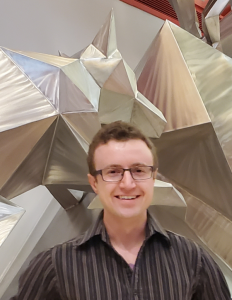Brojo Dhali
 Brojo is a second-year graduate student in “Theis Hyperpolarization Lab” primarily focusing on Signal Amplification By Reversible Exchange (SABRE) technique to enhance the response of compounds in NMR and MRI measurements with the aid of Hyperpolarization. He joined the lab in the summer – of 2022 with a fascination for spin chemistry and is glad to have exciting research opportunities at the forefront of next-generation biomolecular sensing. He completed his BSc in Applied Chemistry & Chemical Engineering in 2019 at The University of Dhaka, Bangladesh, followed by MS in Chemistry in 2021 at The University of South Dakota, USA. He loves singing, traveling, cooking, and spending time with family and friends.
Brojo is a second-year graduate student in “Theis Hyperpolarization Lab” primarily focusing on Signal Amplification By Reversible Exchange (SABRE) technique to enhance the response of compounds in NMR and MRI measurements with the aid of Hyperpolarization. He joined the lab in the summer – of 2022 with a fascination for spin chemistry and is glad to have exciting research opportunities at the forefront of next-generation biomolecular sensing. He completed his BSc in Applied Chemistry & Chemical Engineering in 2019 at The University of Dhaka, Bangladesh, followed by MS in Chemistry in 2021 at The University of South Dakota, USA. He loves singing, traveling, cooking, and spending time with family and friends.
Chris Nelson

Chris attended UNC Wilmington, where he completed his B.S. in 2015 and M.S. in 2020. He joined the Theis lab in 2021 and is interested in the intricacies of Radiowave Amplification through Stimulated Emission of Radiation (RASER) systems for the purpose of growing our understanding of the fundamental mathematics that govern quantum systems
Adam Ortmeier

Adam joined the Theis lab in the summer of 2019. He graduated from Concordia College in Moorhead, Minnesota, with a B.S. in Chemistry and a B.A. in Mathematics. His interests include zero- to ultra-low field NMR, developing and engineering NMR spectrometers, utilization of optics in NMR, and the theory of spin dynamics.
Erica Curran

My interest started as an undergraduate student at the Hyperpolarization Lab in May 2022. My undergraduate research project focused on the optimization of polarization percentage of hyperpolarized [1-13]C pyruvate in increased biocompatible solvent system (ethanol and water). At the graduate level, I would like to expand my interest of hyperpolarization chemistry to move towards toxicological applications. One such application of interest would be through the possible hyperpolarization of PFAS molecules for increased detection in environmental samples. Furthermore, I would like to expand my interest by focusing on the hyperpolarization of certain amino acids to assist in MRI plant imaging.